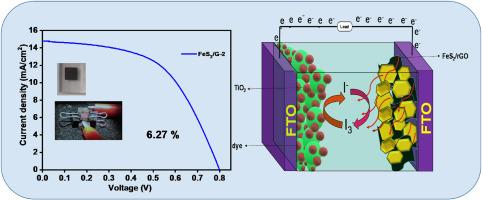FeS2 nanoplates embedded in rGO sheets: A novel nanostructured counter electrode for enhanced DSSC efficiency
IF 6.8
3区 材料科学
Q1 MATERIALS SCIENCE, MULTIDISCIPLINARY
Journal of Science: Advanced Materials and Devices
Pub Date : 2025-08-06
DOI:10.1016/j.jsamd.2025.100962
引用次数: 0
Abstract
Transition metal sulfides (TMS) have gained significant attention as cost-effective, platinum-free alternatives for counter electrodes (CEs) in dye-sensitized solar cells (DSSCs). This work presents a novel nanohybrid composed of hexagonal FeS2 (iron pyrite) nanoplates integrated onto reduced graphene oxide (rGO) sheets as an efficient CE for DSSCs. The nanohybrid was synthesized through a facile one-step solvothermal process and thoroughly characterized, revealing the formation of uniformly distributed crystalline FeS2 nanoplates (1 μm in length and 70 nm in thickness) intricately embedded onto the rGO surface. This innovative FeS2/rGO hybrid demonstrated an impressive power conversion efficiency (PCE) of 6.23 %, significantly outperforming the 4.63 % PCE of standalone FeS2 nanostructures and even exceeding the 5.89 % efficiency achieved by the conventional Pt-based DSSC. The superior performance is attributed to the synergistic effect of the catalytically active FeS2 nanoplates and the electrically conductive two-dimensional rGO framework. This unique architecture enhances the density of catalytically active sites and accelerates ion diffusion pathways, leading to outstanding electrocatalytic activity for triiodide reduction. These results highlight the FeS2/rGO nanohybrid's potential as a highly efficient and sustainable alternative to traditional platinum-based CEs in DSSCs.

嵌入氧化石墨烯片中的FeS2纳米片:一种新型纳米结构对电极,可提高DSSC效率
过渡金属硫化物(TMS)作为染料敏化太阳能电池(DSSCs)中具有成本效益、无铂的对电极(CEs)替代品而受到广泛关注。本研究提出了一种新型的纳米杂化材料,由六方FeS2(黄铁矿铁)纳米板集成到还原氧化石墨烯(rGO)片上,作为DSSCs的高效CE。通过简单的一步溶剂热法合成了该纳米杂化物,并对其进行了全面表征,发现在氧化石墨烯表面形成了均匀分布的晶体FeS2纳米板(长1 μm,厚70 nm)。这种创新的FeS2/rGO混合材料显示出令人印象深刻的功率转换效率(PCE)为6.23%,显著优于独立FeS2纳米结构的4.63% PCE,甚至超过了传统的基于pt的DSSC的5.89%效率。优异的性能归功于催化活性FeS2纳米板和导电二维氧化石墨烯框架的协同作用。这种独特的结构增强了催化活性位点的密度,加速了离子扩散途径,导致三碘化物还原的杰出电催化活性。这些结果突出了FeS2/rGO纳米混合材料作为传统铂基ce在DSSCs中的高效和可持续替代品的潜力。
本文章由计算机程序翻译,如有差异,请以英文原文为准。
求助全文
约1分钟内获得全文
求助全文
来源期刊

Journal of Science: Advanced Materials and Devices
Materials Science-Electronic, Optical and Magnetic Materials
CiteScore
11.90
自引率
2.50%
发文量
88
审稿时长
47 days
期刊介绍:
In 1985, the Journal of Science was founded as a platform for publishing national and international research papers across various disciplines, including natural sciences, technology, social sciences, and humanities. Over the years, the journal has experienced remarkable growth in terms of quality, size, and scope. Today, it encompasses a diverse range of publications dedicated to academic research.
Considering the rapid expansion of materials science, we are pleased to introduce the Journal of Science: Advanced Materials and Devices. This new addition to our journal series offers researchers an exciting opportunity to publish their work on all aspects of materials science and technology within the esteemed Journal of Science.
With this development, we aim to revolutionize the way research in materials science is expressed and organized, further strengthening our commitment to promoting outstanding research across various scientific and technological fields.
 求助内容:
求助内容: 应助结果提醒方式:
应助结果提醒方式:


